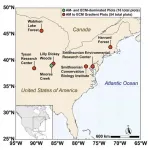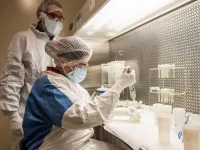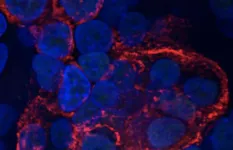INFORMATION:
Photonics for artificial intelligence and neuromorphic computing, B J Shastri et al., Nature Photonics, doi:10.1038/s41566-020-00754-y
New study investigates photonics for artificial intelligence and neuromorphic computing
2021-01-29
(Press-News.org) Scientists have given a fascinating new insight into the next steps to develop fast, energy-efficient, future computing systems that use light instead of electrons to process and store information - incorporating hardware inspired directly by the functioning of the human brain.
A team of scientists, including Professor C. David Wright from the University of Exeter, has explored the future potential for computer systems by using photonics in place of conventional electronics.
The article is published today (January 29th 2021) in the prestigious journal Nature Photonics.
The study focuses on potential solutions to one of the world's most pressing computing problems - how to develop computing technologies to process this data in a fast and energy efficient way.
Contemporary computers are based on the von Neumann architecture in which the fast Central Processing Unit (CPU) is physically separated from the much slower program and data memory.
This means computing speed is limited and power is wasted by the need to continuously transfer data to and from the memory and processor over bandwidth-limited and energy-inefficient electrical interconnects - known as the von Neumann bottleneck.
As a result, it has been estimated that more than 50 % of the power of modern computing systems is wasted simply in this moving around of data.
Professor C David Wright, from the University of Exeter's Department of Engineering, and one of the co-authors of the study explains "Clearly, a new approach is needed - one that can fuse together the core information processing tasks of computing and memory, one that can incorporate directly in hardware the ability to learn, adapt and evolve, and one that does away with energy-sapping and speed-limiting electrical interconnects."
Photonic neuromorphic computing is one such approach. Here, signals are communicated and processed using light rather than electrons, giving access to much higher bandwidths (processor speeds) and vastly reducing energy losses.
Moreover, the researchers try to make the computing hardware itself isomorphic with biological processing system (brains), by developing devices to directly mimic the basic functions of brain neurons and synapses, then connecting these together in networks that can offer fast, parallelised, adaptive processing for artificial intelligence and machine learning applications.
The state-of-the-art of such photonic 'brain-like' computing, and its likely future development, is the focus of an article entitled "Photonics for artificial intelligence and neuromorphic computing" published in the prestigious journal Nature Photonics by a leading international team of researchers from the USA, Germany and UK.
ELSE PRESS RELEASES FROM THIS DATE:
Robotic exoskeleton training expands options for stroke rehabilitation
2021-01-29
East Hanover, NJ. January 29, 2021. A team of New Jersey researchers has demonstrated that high-dose therapy gait training using robotic exoskeletons may aid early rehabilitation for acute stroke. The article, "Robotic exoskeleton gait training during acute stroke inpatient rehabilitation" (doi: 10.339/fnbot.2020.581815), was published October 30, 2020 in Frontiers in Neurorobotics is available open access at: https://www.frontiersin.org/articles/10.3389/fnbot.2020.581815/full
The authors are Karen Nolan, PhD, Kiran Karunakaran, PhD, and Kathleen Chervin, of Kessler Foundation, Michael Monfett, MD, of Children's Specialized Hospital, Radhika Bapineedu, MD, and Neil N. Jasey Jr, MD, of Kessler Institute for Rehabilitation, and Mooyeon Oh-Park, MD, ...
Automated AI algorithm uses routine imaging to predict cardiovascular risk
2021-01-29
Coronary artery calcification -- the buildup of calcified plaque in the walls of the heart's arteries -- is an important predictor of adverse cardiovascular events like heart attacks. Coronary calcium can be detected by computed tomography (CT) scans, but quantifying the amount of plaque requires radiological expertise, time and specialized equipment. In practice, even though chest CT scans are fairly common, calcium score CTs are not. Investigators from Brigham and Women's Hospital's Artificial Intelligence in Medicine (AIM) Program and the Massachusetts General Hospital's Cardiovascular Imaging Research Center (CIRC) teamed up to develop and evaluate a deep learning system ...
Remdesivir disrupts COVID-19 virus better than other similar drugs
2021-01-29
In the treatment of SARS-CoV-2, the virus that causes COVID-19, antiviral drug remdesivir has emerged as a promising candidate.
Remdesivir works by disrupting the virus's ability to replicate, but its exact mechanism has remained a mystery. Using advanced computational simulations, researchers at the Pritzker School of Molecular Engineering (PME) at the University of Chicago have revealed just how the drug works at the molecular level. They also found that two drugs that work in a similar manner, ribavirin and favilavir, do not bind as effectively to the virus.
"It's important to understand ...
Researchers use AI to help businesses understand Code of Federal Regs, other legal docs
2021-01-29
Researchers at the University of Maryland, Baltimore County (UMBC) have made strides in automated legal document analytics (ALDA) by creating a way to machine-process the Code of Federal Regulations (CFR). The CFR is a complex document containing policies related to doing business with the federal government. All business affiliates of the federal government must comply with the CFR. For government contracts to be equitably open to a broad range of businesses, policies within the CFR must be accessible.
This document automation is just one part of a broader project to help contractors and other entities manage and monitor ...
Americans like sports, but heterosexual men especially do
2021-01-29
COLUMBUS, Ohio - Nearly nine out of 10 Americans say they enjoy sports at least a little, but heterosexual men more commonly identify as passionate sports fans, a new study suggests.
A survey of nearly 4,000 American adults found that only 11% said they did not identify as sports fans at all. Over 40% were passionate fans, identifying themselves as being "quite a bit" or "very much so" sports fans.
About 60% of heterosexual men in the survey identified as passionate sports fans, compared to about 40% of both heterosexual women and lesbians. About 30% of gay men reported being passionate sports fans.
"We found that U.S. adults respond overwhelmingly that they are sports fans," said Chris Knoester, co-author of the ...
Scientists look to soils to learn how forests affect air quality, climate change
2021-01-29
Trees are often heralded as the heroes of environmental mitigation. They remove carbon dioxide from the atmosphere, which slows the pace of climate change, and sequester nutrients such as nitrogen, which improves water and air quality.
Not all tree species, however, perform these services similarly, and some of the strongest impacts that trees have on ecosystems occur below the surface, away from the eyes of observers. This complicates efforts to predict what will happen as tree species shift owing to pests, pathogens, and climate change as well as to predict which species are most beneficial in reforestation ...
Explaining to your child why behavior is wrong may not always work
2021-01-29
Parents know the scenario all too well: their child misbehaves and it comes time for discipline.
Research conducted globally shows that spanking is not the best option. But verbal reasoning, which explains why the behavior is wrong, may not always have the intended positive effect if the parent is loud and abrupt, according to a new University of Michigan study.
The findings indicate both positive and negative outcomes that could have lasting consequences on children's emotional development. Verbal reasoning was associated with higher levels of getting along with others, but also with increased aggression and higher levels of distraction.
"Positive discipline doesn't always seem to have all that many positive benefits," ...
COVID unemployment assistance puts food on the table: BU study
2021-01-29
Another wave of COVID-19 is putting millions out of work, while tens of millions more remain unemployed, and Congress debates aid.
Now, a new Boston University School of Public Health (BUSPH) study shows that unemployment help directly translates to people being able to put food on the table.
The CARES Act--passed in March of 2020-- expanded unemployment insurance coverage, amount, and duration.
Published in JAMA Network Open, the study finds that receiving unemployment insurance cuts a person's risk of food insecurity by a third, and halves the likelihood of needing to eat less because of financial constraints. And receiving more coverage, such as the weekly $600 supplement included in CARES until last July, means an even bigger reduction in the risk of going hungry.
"There ...
It's elemental: Ultra-trace detector tests gold purity
2021-01-29
RICHLAND, Wash.?Unless radon gas is discovered in a home inspection, most people remain blissfully unaware that rocks like granite, metal ores, and some soils contain naturally occurring sources of radiation. In most cases, low levels of radiation are not a health concern. But some scientists and engineers are concerned about even trace levels of radiation, which can wreak havoc on sensitive equipment. The semiconductor industry, for instance, spends billions each year to source and "scrub" ultra-trace levels of radioactive materials from microchips, transistors and sensitive sensors.
Now chemists at the U.S. Department of Energy's Pacific Northwest National Laboratory have developed ...
How coronavirus damages lung cells within mere hours
2021-01-29
What if scientists knew exactly what impact the SARS-CoV-2 virus had inside our lung cells, within the first few hours of being infected? Could they use that information to find drugs that would disrupt the virus' replication process before it ever gets fully underway? The discovery that several existing FDA-approved drugs--including some originally designed to fight cancer--can stop coronavirus in its tracks indicates the answer is a resounding yes.
A team of Boston University researchers--hailing from BU's National Emerging Infectious Diseases Laboratories ...



